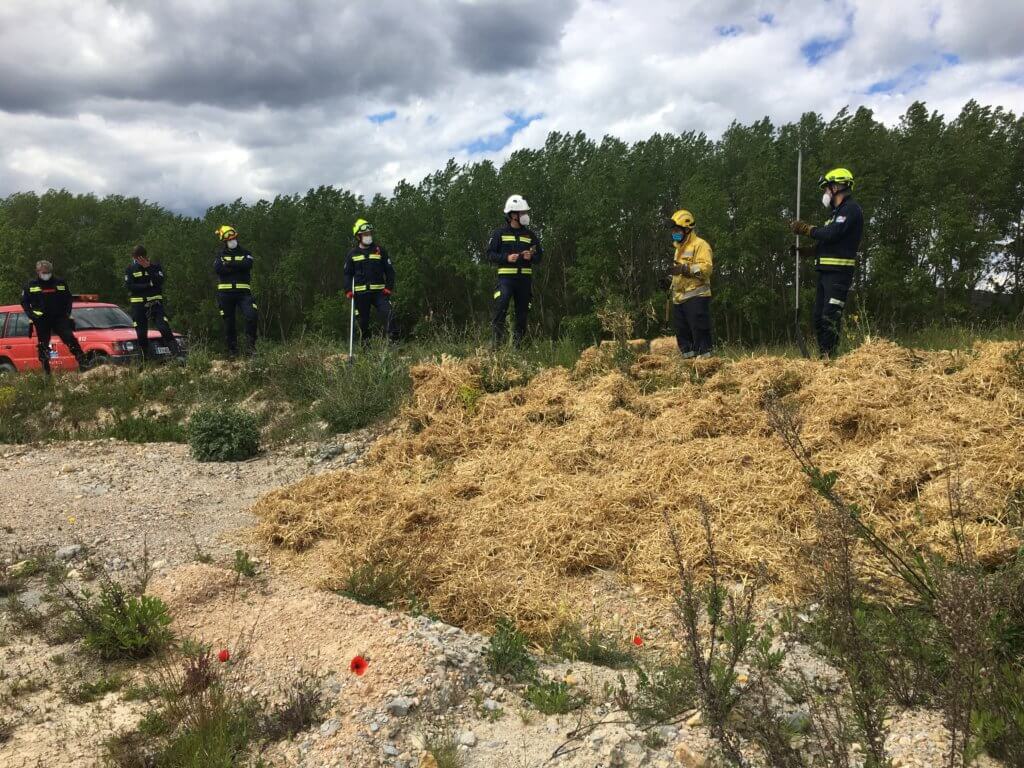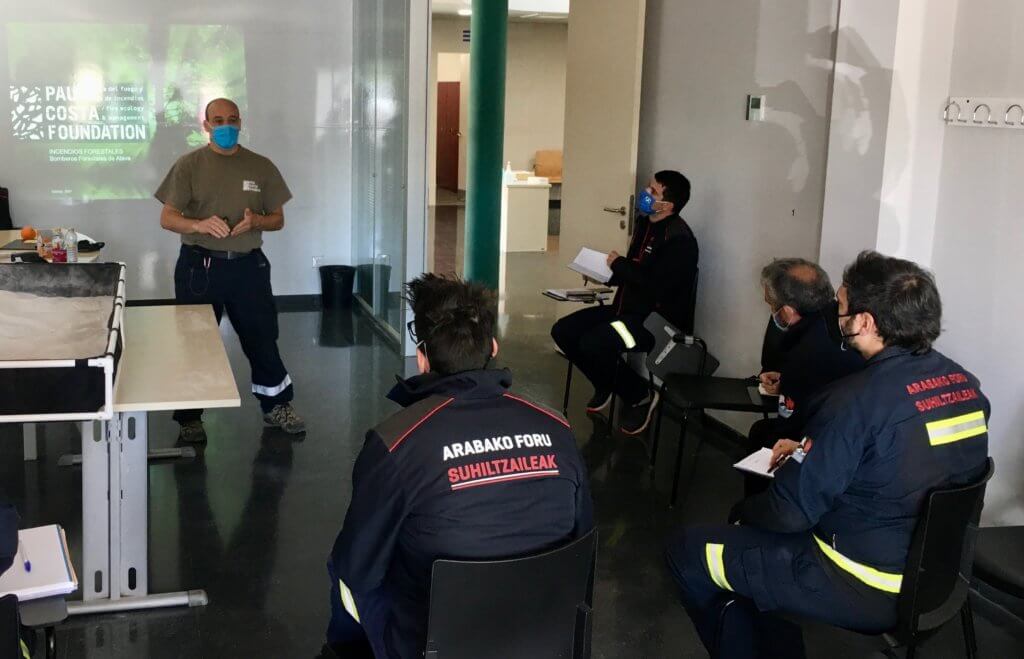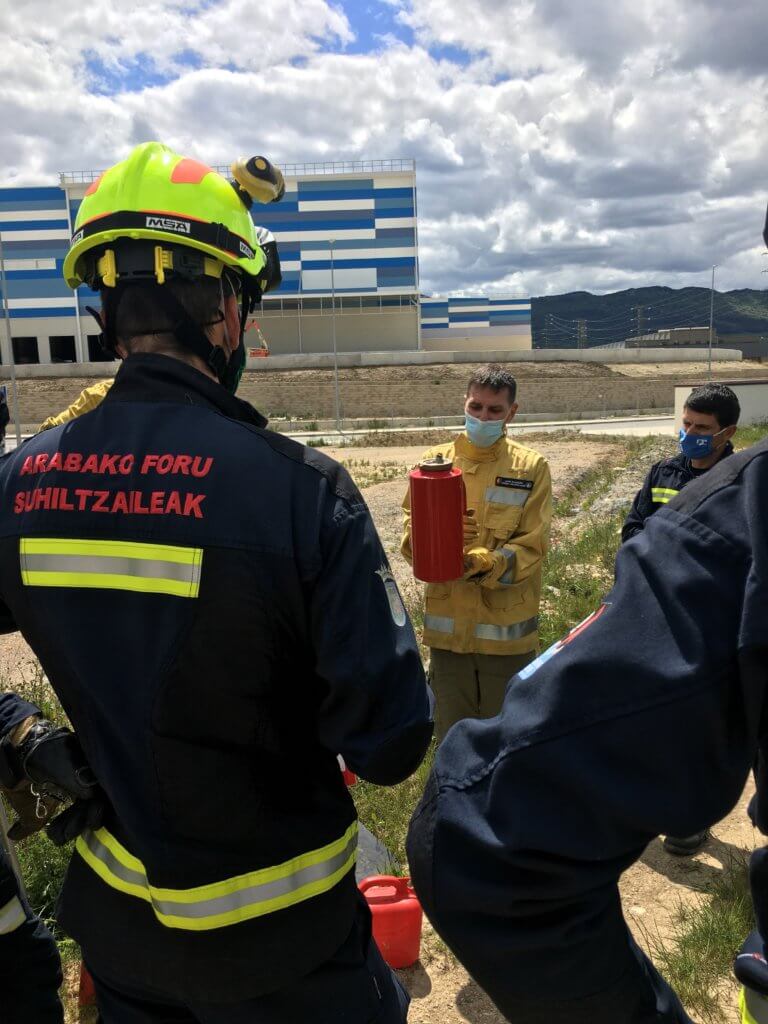BASQUE-ING IN FIRE KNOWLEDGE
PAU COSTA FOUNDATION INTRODUCES PRESCRIBED FIRE AND TACTICAL BURNS TO ÁLAVA FIREFIGHTERS
BY KATHLEEN UYTTEWAAL
After more than a year without leaving our regions in Spain, COVID-19 measures finally eased in May 2021. The Pau Costa Foundation pounced, sending two seasoned experts and former firefighters (now fire lighters!) to cross the peninsula to Álava in the Basque Country. Juan Caamaño plowed through the west from Ávila, while Jordi Pagès skirted the Pyrenees from Lleida with a novice PhD student in tow – me! I had yet to leave the confines of my online research world; this is what happens when you start a PhD in May 2020. I was long overdue to witness fire knowledge in action.
Álava isn’t high on the radar yet for forest fire risk: the vegetation is almost offensively green year round. But the Álava suhiltzaileak (that’s Basque for firefighters) still enthusiastically invited the Pau Costa experts for a three-day introduction to fire management course, training local fire managers on prescribed burns and tactical uses of fire. (Note: a prescribed burn aims to achieve certain habitat/fuel management goals under predetermined conditions; a tactical burn is used during a fire event as a method to redirect or contain it.)

PHOTO BY KATHLEEN UYTTEWAAL
FIRE ENERGIZES OUR ECOSYSTEMS
Pagès and Caamaño set the backdrop by drawing on many of their own international experiences and lessons. They delved into essential context on local fire ecologies and cultures in Spain, the myth of achieving zero fires on the landscape, and encouraged the suhiltzaileak to consider fire as another tool in the management toolbox. “After all,” shared Caamaño, “every year we are better equipped to extinguish fires, but it is not a long-term solution to current and future forest fire problems.” To this, the 20 participants from Álava nodded in unison.
While some aspects of fire remain out of human control, Caamaño emphasized that “in prescribed fires, I choose the conditions of the fire, not the other way around.” The trick is in reframing our concerns as fire managers: it is not about if our landscapes will burn, but how we want them to burn, he said. For this, the instructors shared their knowledge on technical parameters of controlled burning.
Within the prescribed-burn toolbox, Pagès and Caamaño developed exercises on the controlled burn patterns fire managers can use under various conditions of topography and vegetation: lines, points, flanks, and head fires among others. “Careful,” Pagès warned. Another tool can either help or hurt fire managers: the weather. The meteorology will always be dynamic, and conditions will change throughout the day. “No matter what, we need to adapt to it,” Pagès said.
Shifting to tactical burns, Pagès asked: “What does the fire want to burn? Everything! But even a small discontinuity can have a big impact in how we manage it.” Just like fire managers, he said, the fire also reads the wind and counter-winds looking for opportunities to expand. It is necessary to find the opportunity to control the fire with the least amount of risk, smoke and irradiation. How can we use tactical fires, then, Pagès asked. To generate “black zones,” avoid secondary foci, reduce fire perimeter length, and redirect/narrow/close a front.
Pearls of wisdom when conducting prescribed or tactical burns:
- Ask yourself, “What is the worst situation possible?” and start to work from there.
- Never think in the present while working a fire – think of the future conditions.
- There is no concrete recipe for combining all fire-management tools, but think about the convenient and inconvenient aspects of every tool available.
- If there is no natural line to help control a fire, then make one.
- There must always be at least one factor in your favor (slope, wind or suction) and a certain proximity to the fire front.
- It’s important to understand the physics of fire, such as the dynamics that will move the fire column, to play in favor of management decisions.
- Take a step back: instead of thinking about fire trucks, think about objectives. And then firefighters have sufficiently open minds to think about other tools.
- In the window of prescribed burns, think of tools and techniques like gears on a vehicle, from slow to high intensity, depending on what needs to be managed in the territory.

PHOTO BY KATHLEEN UYTTEWAAL
In Caamaño’s words: “I’m not going to play a game that I know I’m going to lose. I will always win if I know my limits well. So always place yourself in the winner’s seat.”
MINIATURE LANDSCAPES, BIG IMPACTS
The suhiltzaileak put their newly acquired tools and axioms to the test. When the chirimiri (that’s the word for fine, constant rain in Basque) permitted, the firefighters experimented burning straw pile mounds. These miniature versions of crests, slopes, and valleys helped them get a feel for how these topographical characteristics (along with weather) can radically change fire behavior. The firefighters split into groups and assigned a burn boss to decide the desired control burn pattern according to the topographic and wind conditions.
In another straw pile exercise, we observed how fire interacted with the crest and wind. This helped us think on our feet about the opportunities we have in a situation like this: Where can we place extinguishing tools? What are the (in)conveniences of each decision?
NOT YOUR ORDINARY SANDBOX
Pagès and Caamaño crafted another exercise sure to hit close to home. Using a projector and a sand table, they generated a 3D topographical representation of a hillside right next to the Álava firefighter base. It was up to the firefighters to decide how to burn it in parcels.
What seemed like simple triangles and rectangles overlayed on the hillside suddenly became much more complex. So many decisions determine how to manage the territory under certain conditions. It took teamwork to organize, plan and execute the burn. The firefighters had to communicate quickly about principle objectives, the range of acceptable results, structural complexity, preparing the terrain, resource provisioning, security conditions, and communicating with the public. The groups split up for briefing which, the Pau Costa experts declared, is the most essential moment for fire crews. They then ran through the entire burn operation: assigning the ignition team; control team; the communication network; the contention plan; considering possible escape areas; base lines, patterns and point of ignition; subdividing the parcel; and a security plan.

PHOTO BY KATHLEEN UYTTEWAAL
As a fly on the wall, I was thoroughly impressed with the knowledge integration, co-operation and quick decision making throughout these days. The hierarchical command systems are clear among fire managers, and teamwork is so practiced that action seems to happen almost fluidly. While research has its own set of challenges for fire management, the weight of these fire managers’ responsibilities was much more palpable as they place their minds and bodies forward daily. One fire manager joked, “Even when it rains, it’s my fault!”
The suhiltzaileak felt equipped and motivated with their new toolbox, though they shared how difficult it would be to immediately implement prescribed burns in the area due to unfavorable policies and closed administrative mindsets. This is not news to the instructors.: “It is much faster to change people’s hearts than to change institutions,” Caamaño said. Undoubtedly, the suhiltzaileak started on that journey during this training. It is up to organizations like the Pau Costa Foundation and a wide network of passionate allies, from fire managers, landowners, administrators, researchers and even foreign PhD students, to accompany that process and light more good fires along the way.
ABOUT THE AUTHOR

Kathleen Uyttewaal is a PhD candidate working at the Pau Costa Foundation, and she is affiliated with Wageningen University in the Netherlands through the PyroLife Innovative Training Network. Primarily raised in California, she has family roots in France and has lived in Catalonia nearly three years. Fire first sparked her interest when she witnessed its devastating and healing effects in rural California. She carries these lessons with her for current participatory research on how rural Mediterranean communities adapt to living with wildland fire.
